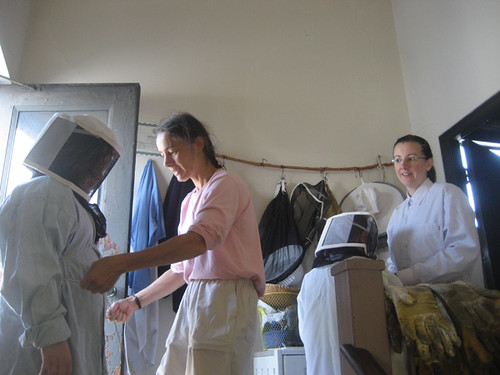
Some people get up early to eat Sunday breakfast out. Okay, that’s us most weeks. This week, we got up early to harvest it. And I don’t mean corn for cornmeal muffins.

You would never guess, walking by the old convent next to a Catholic church in Rogers Park, that the roof was doubling as an apiary. The building (incongruously Art Deco for a convent) is now the Marjorie Kovler Center of the Heartland Alliance, once better known as the Travelers & Immigrant Aid Society and helping immigrants to Chicago since 1888. One of the staffers, Mary Black, who works with refugees and torture victims as an occupational therapist, had been interested in beekeeping and found that it was often a skill that turned up among immigrants in their programs. A grant from Heifer International for livestock enabled her to start hives on the roof, with an Eastern European man named something like Mirostat (I never quite heard it right) as the master beekeeper. [EDIT: my wife heard, I didn’t, that he’s a teacher at Roosevelt High School named Mirsad and one set of hives are his school project bees.]

In addition to the Kovler center’s own bees, there are a couple of other groups keeping hives on the roof; we were there at the invitation of one of the teachers from our kids’ school.
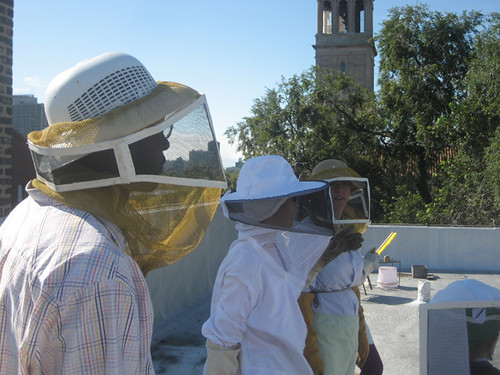
A man from Cameroon named Goodwin (left) helped us with the bees today. He told us about beekeeping in Cameroon, where they lacked the protective gear we used today. In Cameroon, the way you avoid getting stung is, when they come after you, you run and jump in the river.
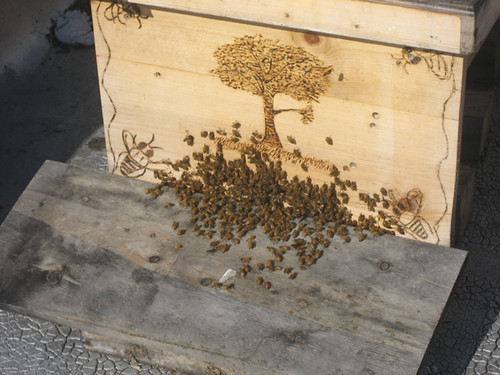
I wondered if we’d still have a visceral reaction to bees swarming around us but you soon feel quite invulnerable in your protective gear (even though you’re not, really). The bees are very good at sealing up where they live and work with goo of their own making, so you first use a “hive tool” to pry the hives open, smoking them to calm them down and chase them away:
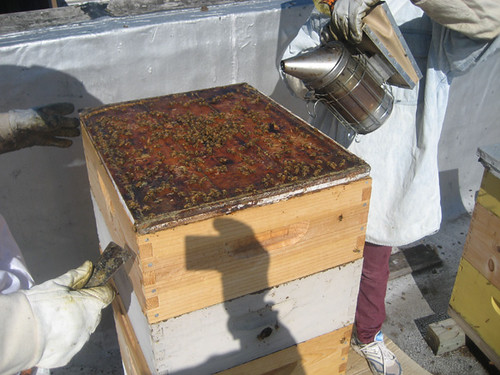

Some of the combs were neat like this one, some almost overgrown with bee-stalactites of wax:

You want the ones that are “capped,” which means each individual cell in the comb is full and closed off. We took about half the honey, and left the other half for them to live on over the winter. Goodwin asked how they get out to feed if there’s lots of snow covering up their entrance to the hive. We explained that, well, they don’t, because there’s nothing to feed on in the winter. Another difference between beekeeping in Chicago and in Cameroon.

Goodwin brushed the bees off the comb…
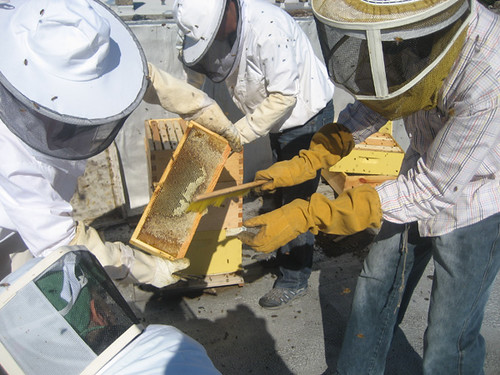
and Myles and Liam, unphased by bees all around them, opened the box where the combs, as bee-free as we could get them, were kept to carry downstairs.
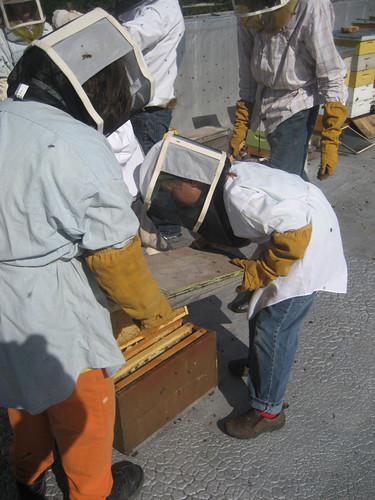
Sometimes if a comb was covered with bees, they’d just knock it on the ground, and the slightly dazed bees would just sit there, wondering what the heck just happened.

The white blobs are drones; unfortunately the black spots are signs of an infestation, mites that prey on bee colonies, so treatment will have to be applied in the next couple of weeks.
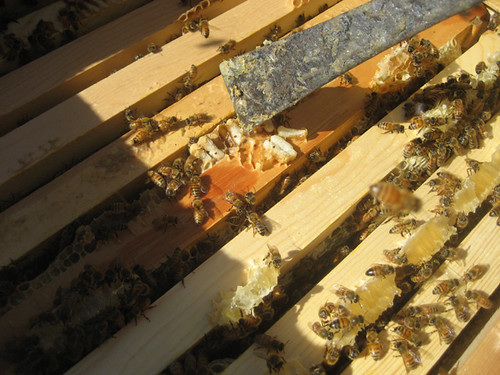
Under the watchful eye of the teacher, Mrs. Holdrege, both kids went to work uncapping the combs, which basically means using a thing sort of like a pet comb to neatly scrape the top layer of wax to open the cells without scraping up too much honey. They did surprisingly well with this delicate operation.
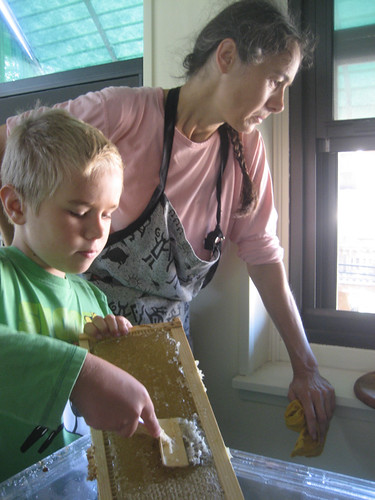
Then into the centrifuges, which the kids loved cranking. Me, I soon remembered the nice motor-powered centifuges Peter Fonda had in the movie Ulee’s Gold.
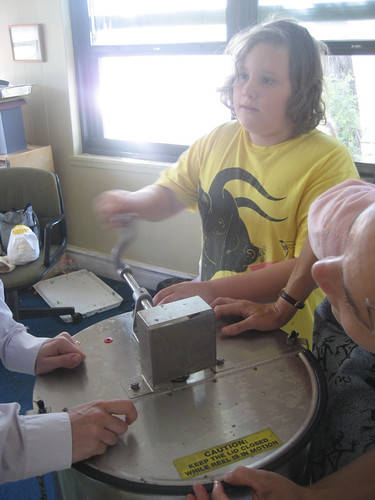
I expected we’d get a couple of good-sized jars. We filled two 5-gallon buckets most of the way… after more than an hour of cranking.

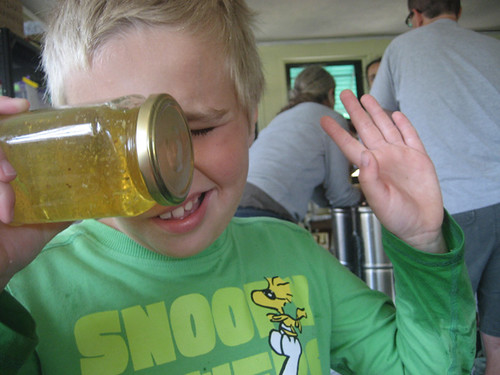
Some are freaked out by the bits of comb, stray bee legs, etc. that speckle the honey in the buckets, and so they filter it before eating it. We ate the raw honey on bread and apples undaunted, and it was wonderful. I’ve had plenty of really great honey in recent years but this stuff fresh from the combs was in its own class, floral and incredibly fresh tasting. We came home with a beautiful jar, the foreign matter has already pretty much floated to the top.
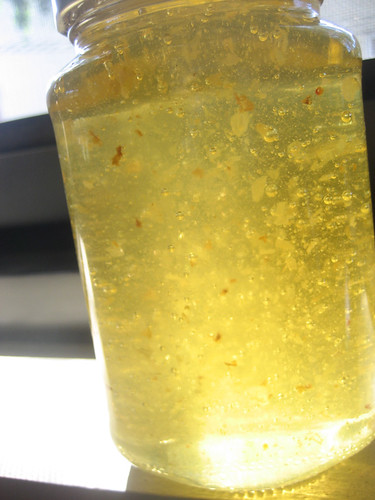
I think biscuits will be on the menu for dinner.
Update: Here’s a link to a video about Heartland Alliance.


 If you like this post and would like to receive updates from this blog, please subscribe our feed.
If you like this post and would like to receive updates from this blog, please subscribe our feed.




